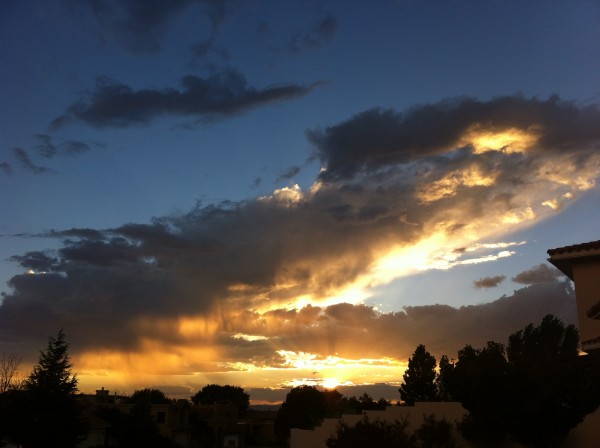Cloud Calling
by Bruce • June 17, 2017 • LifeStuff • 0 Comments
Living in New Mexico, I’ve spent a fair amount of time outside, and I’ve learned when I am outside to frequently look up. New Mexico puts on some wonderful sky shows with its endless vertical expanses of deep blue and sculpted whites.
The clouds have always drawn my eyes. They provide a drama all their own, giving expression to nature’s moods during the day, conveying joy and play, anger and grief.
However, despite how much I’ve looked up, I’ve never taken the time to learn what the clouds are named. I’ve had friends see a formation and easily say “those are so-and-so clouds”, and I wondered where they got their meteorological degree. I’m not a strong technical student. Long words and names don’t stay in my head very long.
But I’m also in a “Learning to Look” mode, trying to collect words that help me to understand and to communicate about this state I live in and love.
I’ve been thumbing through the National Audobon Society guide to the Southwest to learn about various topics, and within it I came across a few pages on clouds that were very helpful, describing for me the different cloud types we see.
Using those descriptions, though, I went on the internet and discovered what was most helpful to me for demystifying the names: the English meaning of the Latin word roots. Give me the word’s linguistic base, and I am pretty good at remembering categories by those.
And it turns out, cloud classifications are not as mystical as I thought.
The following five Latin stems (with their English translations) made cloud names easily meaningful for me:
stratus: “spread out”
cumulus: “heap, pile”
cirrus: “curl”
nimbus: “rain”
alto: “high”
Based on the above stems, we can infer what cloud formations are most likely named based on their appearance. Stratus clouds are layers or walls, banks that fill the sky like a big sheet draped over some or all of it. Cumulus clouds are piles- those amorphous puffs or blobs we like to see puppy heads or alien spaceships in. Cirrus clouds, a special set, are high-altitude arcs- distant wispy, stringy or blotchy strands drifting in the sky.
Combinations of these five stems make up the names of most of the clouds we see rolling over us day by day.
Do clouds look like they are preparing or are busy storming? If they are puffy piles, they are cumulonimbus clouds (“rain” + “piles”), which at times are also recognized as thunderheads. If they are a gray bank, they are nimbostratus (“rain” + “layer”).
The main thing left for helping us to attach names to particular cloud formations is to locate clouds at altitudes, and “alto” and “cirrus” helps us with those names.
Basically, clouds of the basic categories that sit somewhere between 6,500 and 20,000 feet are considered “high” and granted the alto prefix. Got a long smooth swath of white up there? Thats an altostratus cloud. A group of puffs? Those are altocumulus clouds.
Cirrus clouds follow the altitude schema, but they are clouds above alto formations. Designated as curly or ringed clouds, cirrus formations are actually high-altitude formations (5 miles and up) that often appear arced, wispy, stringy, blotchy, or strandlike due to distance and atmospheric conditions. There are cirrostratus (“curly” + “layer”) and cirrocumulus (“curly” + “piles”) clouds, and simply enough, there are plain old cirrus (“curly”) clouds that look like a collection of arcs high in the sky.
There are a few special cloud terms worth remembering as well.
virga: “branch, root”. Those streamers of rain underneath a rain cloud that look like roots.
lenticular clouds: from the root for “lens”. Clouds that look like a contact lens or lentil bean- long, flat, smoothly curved- laying horizontal to the horizon in the sky, often over mountain peaks.
mammatus clouds: from mamma, “udder, breast”. These unique cumulonimbus clouds look they have pouches or udders under them.
Towering cumulus. If cumulus means “piles”, occasionally, there are some super tall cumulus clouds in the sky. Those are not just cumulus clouds- they are “towering cumulus”.
Now having an operating set of terms to call the clouds when I look up to watch them, I need to using them.
We’ve been around each other certainly long enough. It’s probably about time we begin recognizing each other by our names.

